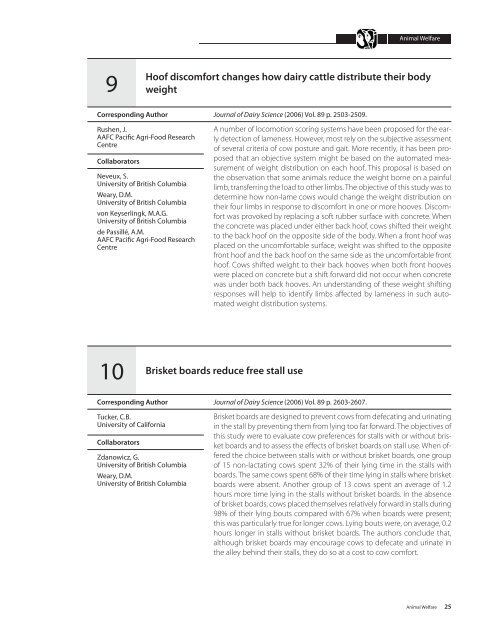A52-75-2007E.pdf - AgroMedia International Inc
A52-75-2007E.pdf - AgroMedia International Inc
A52-75-2007E.pdf - AgroMedia International Inc
You also want an ePaper? Increase the reach of your titles
YUMPU automatically turns print PDFs into web optimized ePapers that Google loves.
Animal Welfare9Hoof discomfort changes how dairy cattle distribute their bodyweightCorresponding AuthorRushen, J.AAFC Pacific Agri-Food ResearchCentreCollaboratorsNeveux, S.University of British ColumbiaWeary, D.M.University of British Columbiavon Keyserlingk, M.A.G.University of British Columbiade Passillé, A.M.AAFC Pacific Agri-Food ResearchCentreJournal of Dairy Science (2006) Vol. 89 p. 2503-2509.A number of locomotion scoring systems have been proposed for the earlydetection of lameness. However, most rely on the subjective assessmentof several criteria of cow posture and gait. More recently, it has been proposedthat an objective system might be based on the automated measurementof weight distribution on each hoof. This proposal is based onthe observation that some animals reduce the weight borne on a painfullimb, transferring the load to other limbs. The objective of this study was todetermine how non-lame cows would change the weight distribution ontheir four limbs in response to discomfort in one or more hooves. Discomfortwas provoked by replacing a soft rubber surface with concrete. Whenthe concrete was placed under either back hoof, cows shifted their weightto the back hoof on the opposite side of the body. When a front hoof wasplaced on the uncomfortable surface, weight was shifted to the oppositefront hoof and the back hoof on the same side as the uncomfortable fronthoof. Cows shifted weight to their back hooves when both front hooveswere placed on concrete but a shift forward did not occur when concretewas under both back hooves. An understanding of these weight shiftingresponses will help to identify limbs affected by lameness in such automatedweight distribution systems.10Brisket boards reduce free stall useCorresponding AuthorTucker, C.B.University of CaliforniaCollaboratorsZdanowicz, G.University of British ColumbiaWeary, D.M.University of British ColumbiaJournal of Dairy Science (2006) Vol. 89 p. 2603-2607.Brisket boards are designed to prevent cows from defecating and urinatingin the stall by preventing them from lying too far forward. The objectives ofthis study were to evaluate cow preferences for stalls with or without brisketboards and to assess the effects of brisket boards on stall use. When offeredthe choice between stalls with or without brisket boards, one groupof 15 non-lactating cows spent 32% of their lying time in the stalls withboards. The same cows spent 68% of their time lying in stalls where brisketboards were absent. Another group of 13 cows spent an average of 1.2hours more time lying in the stalls without brisket boards. In the absenceof brisket boards, cows placed themselves relatively forward in stalls during98% of their lying bouts compared with 67% when boards were present;this was particularly true for longer cows. Lying bouts were, on average, 0.2hours longer in stalls without brisket boards. The authors conclude that,although brisket boards may encourage cows to defecate and urinate inthe alley behind their stalls, they do so at a cost to cow comfort.Animal Welfare 25





